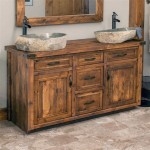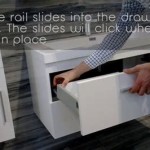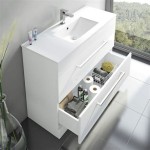How To Stop a Bathroom Sink Faucet From Leaking
A dripping bathroom sink faucet is more than just an annoyance. It wastes water, increases water bills, and can eventually lead to water damage around the sink and cabinet. Understanding the common causes of a leaky faucet and the steps involved in fixing them is crucial for any homeowner. This article provides a comprehensive guide to diagnosing and repairing a leaking bathroom sink faucet, preventing further water waste and property damage.
Before beginning any repair work, safety is paramount. The first step is to shut off the water supply to the faucet. Typically, there are shut-off valves located directly beneath the sink, one for hot water and one for cold water. Turn these valves clockwise until they are fully closed. If shut-off valves are not present or are malfunctioning, the water supply must be turned off at the main water shut-off valve for the entire house, which is usually located near the water meter. Once the water supply is turned off, turn on the faucet to release any remaining water pressure in the pipes. This ensures a safer and more effective repair process.
After shutting off the water supply, the next crucial step involves identifying the type of faucet. Different faucet types have different internal components and require different repair approaches. The four primary types of bathroom sink faucets are compression faucets, cartridge faucets, ball faucets, and ceramic disc faucets. Each type operates with a distinct mechanism for controlling water flow, and knowing the type is the first step to a successful repair.
Identifying the Faucet Type
Compression Faucets: These are the oldest and simplest type. They are easily identified by having two separate handles, one for hot water and one for cold water. Turning the handles moves a stem up and down, compressing a rubber washer against the valve seat to stop the flow of water. Because of the constant compression, the rubber washers in compression faucets wear out relatively quickly, making them a common source of leaks.
Cartridge Faucets: Cartridge faucets have a single handle that moves up and down to control water flow and side to side to control water temperature. Inside the faucet body is a cartridge, a cylindrical component containing O-rings and seals, which regulates the flow of water. Leaks in cartridge faucets often stem from worn or damaged O-rings within the cartridge.
Ball Faucets: Similar to cartridge faucets, ball faucets also have a single handle for controlling flow and temperature. The distinguishing feature is a ball-shaped component inside the faucet body with slots and chambers that control the mixing and flow of water. Leaks in ball faucets are frequently caused by loose adjusting rings or worn O-rings around the ball valve and spout.
Ceramic Disc Faucets: Ceramic disc faucets represent a more modern design. They have a single lever that moves up and down to control flow and rotates to control temperature. These faucets contain two ceramic discs that move against each other to control water flow. They are known for their durability and resistance to leaks, but when a leak does occur, it is often due to sediment buildup or damage to the ceramic discs.
Once the faucet type is identified, the next step is to disassemble the faucet. This requires a few basic tools, including adjustable wrenches, screwdrivers (both Phillips head and flathead), pliers, and possibly an Allen wrench or a faucet stem removal tool. It's also a good idea to have a small container or tray to hold small parts and a clean cloth to wipe up any water or debris.
Disassembling and Inspecting the Faucet
Compression Faucet Disassembly: Start by removing the decorative caps on the handles, if present, using a flathead screwdriver. Underneath the caps, there should be a screw holding the handle in place. Remove the screw and pull the handle off. Next, use an adjustable wrench to loosen and remove the packing nut that holds the stem in place. Once the packing nut is removed, carefully pull out the stem. At the bottom of the stem is the rubber washer. Examine the washer for signs of wear, cracks, or deterioration. Also, inspect the valve seat inside the faucet body for any corrosion or damage.
Cartridge Faucet Disassembly: Locate and remove the handle screw, often hidden under a decorative cap or cover. Once the handle is removed, you may need to use a specialized faucet handle puller if the handle is stuck. With the handle removed, look for a retaining clip or nut that holds the cartridge in place. Remove the clip or nut. Gently pull the cartridge straight up and out of the faucet body. Inspect the cartridge for any cracks or damage. Pay close attention to the O-rings on the cartridge, looking for wear, cracks, or swelling. If the cartridge is difficult to remove, a cartridge puller tool might be needed.
Ball Faucet Disassembly: Begin by loosening the setscrew on the side of the faucet handle using an Allen wrench. Once the setscrew is loose, pull the handle off. Next, loosen the adjusting ring cap with a spanner wrench or adjustable pliers. Remove the cap and the ball valve. Inspect the ball valve for any scratches or damage to its surface. Beneath the ball valve are the inlet seals and springs. Use a small screwdriver or pick to carefully remove the seals and springs. Inspect the seals for wear or damage. Check the spout O-rings as well, as these are common sources of leaks in ball faucets.
Ceramic Disc Faucet Disassembly: Use an Allen wrench or screwdriver to remove the handle. Depending on the model, you might need to remove a decorative cap first. Once the handle is removed, carefully remove the cylinder or cartridge that houses the ceramic discs. Some models have a retaining nut that needs to be loosened first. Inspect the ceramic discs for any cracks, chips, or sediment buildup. Examine the seals and O-rings around the disc cartridge for wear or damage.
After disassembling the faucet and identifying the worn or damaged components, the next step is to replace them. Replacing the correct parts is crucial for stopping the leak effectively. It is always recommended to purchase replacement parts that are specifically designed for the faucet model being repaired. Generic parts may not fit properly and could lead to continued leaks or other issues.
Replacing Worn Components and Reassembling the Faucet
Compression Faucet Repair: Replace the worn rubber washer at the bottom of the stem with a new washer of the same size and type. If the valve seat inside the faucet body is corroded or damaged, it can be resurfaced using a valve seat grinding tool or replaced entirely. Apply plumber's grease to the threads of the stem and reassemble the faucet in reverse order. Don't overtighten the packing nut, as this can make it difficult to turn the handle. Turn the water supply back on slowly and check for leaks around the handle and spout.
Cartridge Faucet Repair: Replace the entire cartridge if it is cracked or damaged. If only the O-rings are worn, carefully remove them using a small pick or screwdriver and replace them with new O-rings of the correct size. Apply plumber's grease to the new O-rings and the cartridge before reinserting it into the faucet body. Replace the retaining clip or nut and reattach the handle. Turn the water supply back on slowly and check for leaks around the handle and spout.
Ball Faucet Repair: Replace the inlet seals and springs with new ones. Ensure that the springs are properly seated before inserting the new seals on top of them. Replace the spout O-rings with new ones, lubricating them with plumber's grease before installation. Reassemble the ball valve, adjusting ring, and handle in reverse order. Tighten the adjusting ring cap until the handle operates smoothly but is not too loose. Turn the water supply back on slowly and check for leaks around the spout and handle.
Ceramic Disc Faucet Repair: If the ceramic discs are cracked or chipped, the entire cartridge must be replaced. If there is sediment buildup, carefully clean the discs with a soft cloth and a mild cleaning solution. Replace any worn or damaged seals and O-rings around the disc cartridge. Apply plumber's grease to the new seals and reassemble the faucet. Turn the water supply back on slowly and check for leaks around the spout and handle.
After reassembling the faucet and turning the water supply back on, carefully inspect for any leaks. Check around the base of the faucet, the spout, and the handles. If leaks persist, it may be necessary to disassemble the faucet again and re-examine the components to ensure they are properly installed and seated. Double-check the O-rings and seals, making sure they are correctly positioned and lubricated. Tighten any loose connections, but avoid overtightening, which can damage the parts.
In scenarios where the faucet is severely corroded or damaged, or if the repair proves too complex, it may be necessary to replace the entire faucet. Replacing a faucet involves disconnecting the water supply lines, removing the old faucet, and installing a new one. Ensure that the new faucet is compatible with the sink's mounting holes and that all connections are properly sealed to prevent leaks.
Preventative maintenance can significantly extend the life of a faucet and reduce the likelihood of leaks. Regularly cleaning the faucet and aerator to remove sediment buildup can help maintain proper water flow and prevent damage to internal components. Periodically lubricating the faucet's moving parts with plumber's grease can also help prevent wear and tear. Furthermore, promptly addressing any signs of leaks, even small drips, can prevent more significant problems and water waste in the long run. Consider installing water leak detectors to alert you to potential plumbing issues early on.
Successfully stopping a bathroom sink faucet from leaking requires careful diagnosis, proper disassembly, accurate parts replacement, and meticulous reassembly. By following these steps and taking preventative measures, homeowners can effectively address faucet leaks, conserve water, and avoid costly repairs. However, if unfamiliar with plumbing repairs or encounter complications, consulting a qualified plumber is always the safest and most reliable option.

How To Fix A Leaky Faucet True Value

5 Reasons Your Faucet Is Dripping Water How To Fix It

Simple Ways To Fix A Leaky Delta Bathroom Sink Faucet

4 Easy Ways To Fix A Leaky Bathroom Sink Faucet With Double Handle

Bathroom Faucet Is Leaking Or Dripping

How To Fix A Leaky Faucet The Home Depot

How To Fix A Leaky Bathroom Sink Faucet

5 Reasons Your Faucet Is Dripping Water How To Fix It

4 Easy Ways To Fix A Leaky Bathroom Sink Faucet With Double Handle

How To Fix A Leaky Faucet Handle
Related Posts







